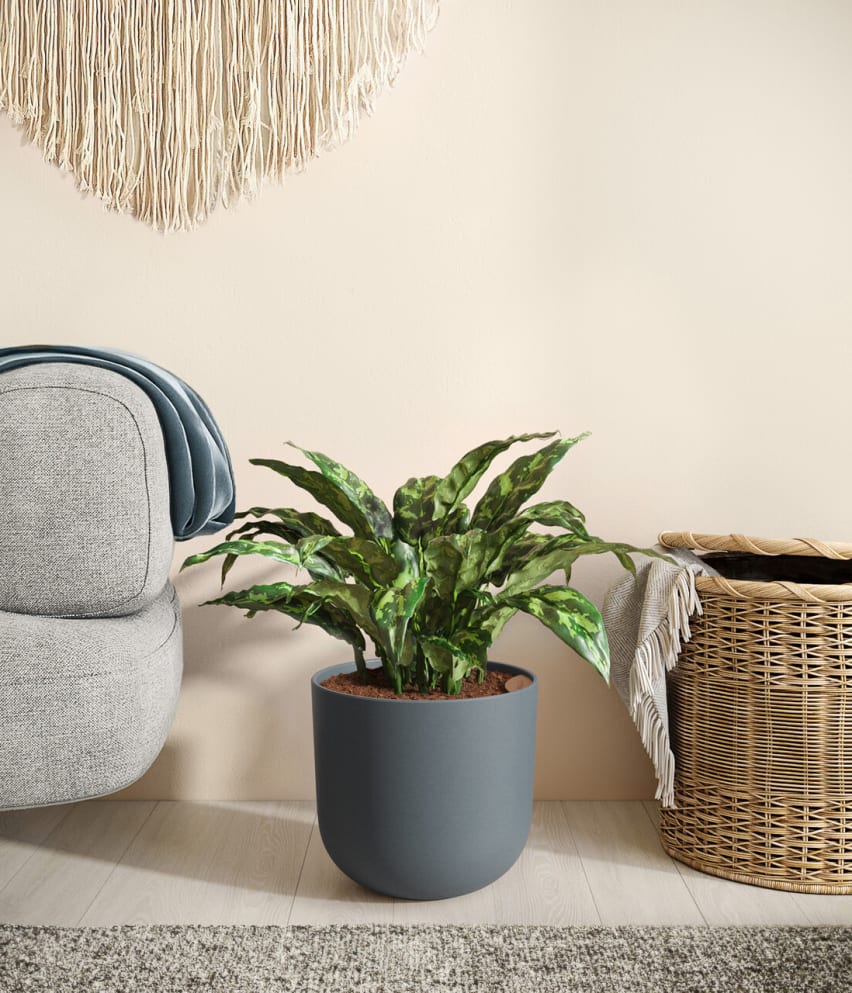How to Care for Christmas Cactus
Shop this plantAbout Christmas Cactus
The Christmas cactus, scientifically known as Schlumbergera, is a favorite holiday plant with a festive flair. Originating from the tropical rainforests of Brazil, it is known for its vibrant blooms that appear, as if by magic, during the winter holidays. Unlike other cacti, the Christmas cactus is a tropical epiphyte that thrives in a more humid environment.
Other common names
- Schlumbergera
- Thanksgiving cactus
- Crab cactus
- Holiday cactus
How Often Should I Water My Christmas Cactus
With easyplant’s self-watering pot, caring for your Christmas Cactus is straightforward. Just check the easyplant reservoir once a month and refill it if empty, ensuring the topsoil is dry, to keep your plant perfectly hydrated.
Christmas Cactus Light Needs
Christmas Cactus grows best in a space with bright indirect light, where the sun rays are diffused, and can also adapt to spaces with medium to low light. Avoid placing it in spaces without natural light or with direct sunlight.
The ideal spot for your Christmas Cactus would be near an east or north-facing window where it can enjoy the morning light without the harsh intensity of the afternoon sun. This level of light will encourage robust health and plentiful blooms without risking damage to the delicate leaves.
Christmas Cactus Plant Care
Caring for your Christmas Cactus is a breeze with an easyplant self-watering pot. To further enhance its growth and ensure it develops evenly, simply rotate the pot a quarter turn each month. This helps every side of the cactus get an equal share of light, contributing to its overall symmetry and beauty. Maintain a consistent temperature above 50°F in the room to keep your plant comfortable, especially during the cooler months. In addition to proper lighting and temperature, ensuring the right humidity level will keep your Christmas Cactus healthy. If you live in a particularly dry climate, grouping it with other plants or using a pebble tray can provide the extra moisture this tropical cactus loves. By following these simple steps, you can ensure your Christmas Cactus not only thrives but becomes a stunning feature in your home, bringing joy and vibrant color to any space.
How Big Will My Christmas Cactus Grow?
With the right care, your Christmas Cactus can become quite a showpiece, potentially spreading out to two feet wide and reaching up to a foot in height. Its growth pattern is characterized by horizontal branching and arching stems, making it a striking addition to any interior setting. Ideally placed on a high shelf or in a prominent spot, it grows at a moderate rate, allowing you to enjoy its verdant presence and seasonal flowering without worrying about it outgrowing its space.
Temperature & Humidity
The Christmas cactus enjoys the same temperature range as most homes, preferring conditions between 60-70°F. However, to initiate the blooming process, they benefit from cooler temperatures (around 50-55°F) in the fall. They also favor a higher humidity level, which can be easily achieved by placing a pebble tray with water beneath the plant, using a humidifier, or simply grouping it with other houseplants to create a more humid microclimate.
Are Christmas Cacti Toxic for Pets & Kids?
Christmas cacti are non-toxic to both pets and children, making them a safe and festive choice for a household plant.
Troubleshooting Common Problems with Christmas Cactus
If you notice a bit of wilting in your Christmas cactus during the initial days after bringing it home, rest assured it's a common response. The transition from box to your home environment can be a bit of an adjustment for the plant. Give it some time to acclimate, and soon enough, it should perk up as it settles into its new surroundings. If you see that the leaves of your Christmas cactus are wilting or looking limp, this could be a sign of overwatering. Ensure the top inch of soil is dry and that the reservoir is empty before you refill again. Conversely, if the leaves appear shriveled or puckered, your Christmas cactus may need more water. Make sure you follow the watering instructions of your easyplant. If you notice your Christmas cactus isn't blooming, give it a bit more darkness each night, aiming for about 12-14 hours of uninterrupted darkness to encourage bud formation. Bud drop can sometimes occur with sudden changes in temperature or light, so once buds begin to form, keep the plant in a stable environment and try not to move it. Yellowing leaves may indicate that the plant is getting too much direct sunlight. If placed in a very bright spot, move your cactus to a location where the light is bright but indirect. Remember, each Christmas cactus has its own personality and may take some time to show you what it needs. With these troubleshooting tips, you can ensure your Christmas cactus remains a vibrant and joyful part of your home.
Frequently Asked Questions about Christmas Cactus Plant
- Does Christmas cactus like sun or shade?
The Christmas cactus prefers bright but indirect sunlight. Too much direct sunlight can damage the leaves, so it's best placed in a spot that mimics the natural shade of its native environment, like near a north or east-facing window.
- What triggers a Christmas cactus to bloom?
Shorter daylight hours and cooler nighttime temperatures in the fall naturally trigger a Christmas cactus to bloom. You can encourage blooming by providing approximately 12-14 hours of darkness each night and reducing the temperature to about 50-55°F for several weeks before the desired bloom time.
- What is the lifespan of a Christmas cactus?
A well-cared-for Christmas cactus can live and thrive for 20 to 30 years, sometimes even longer. With proper care and favorable conditions, these plants can become long-standing, cherished members of your houseplant collection.
- How do I take care of my Christmas cactus?
Caring for your Christmas cactus involves placing it in bright, indirect light, watering when the top inch of soil is dry, and ensuring it has enough humidity. During its blooming season, ensure it gets 12-14 hours of darkness and slightly cooler temperatures to encourage flowering. Rotating the plant regularly and keeping it away from drafts or heat sources will also promote its health and longevity.



 Small Plants
Small Plants Medium Plants
Medium Plants Large Plants
Large Plants Huge Plants
Huge Plants Plants Collections
Plants Collections